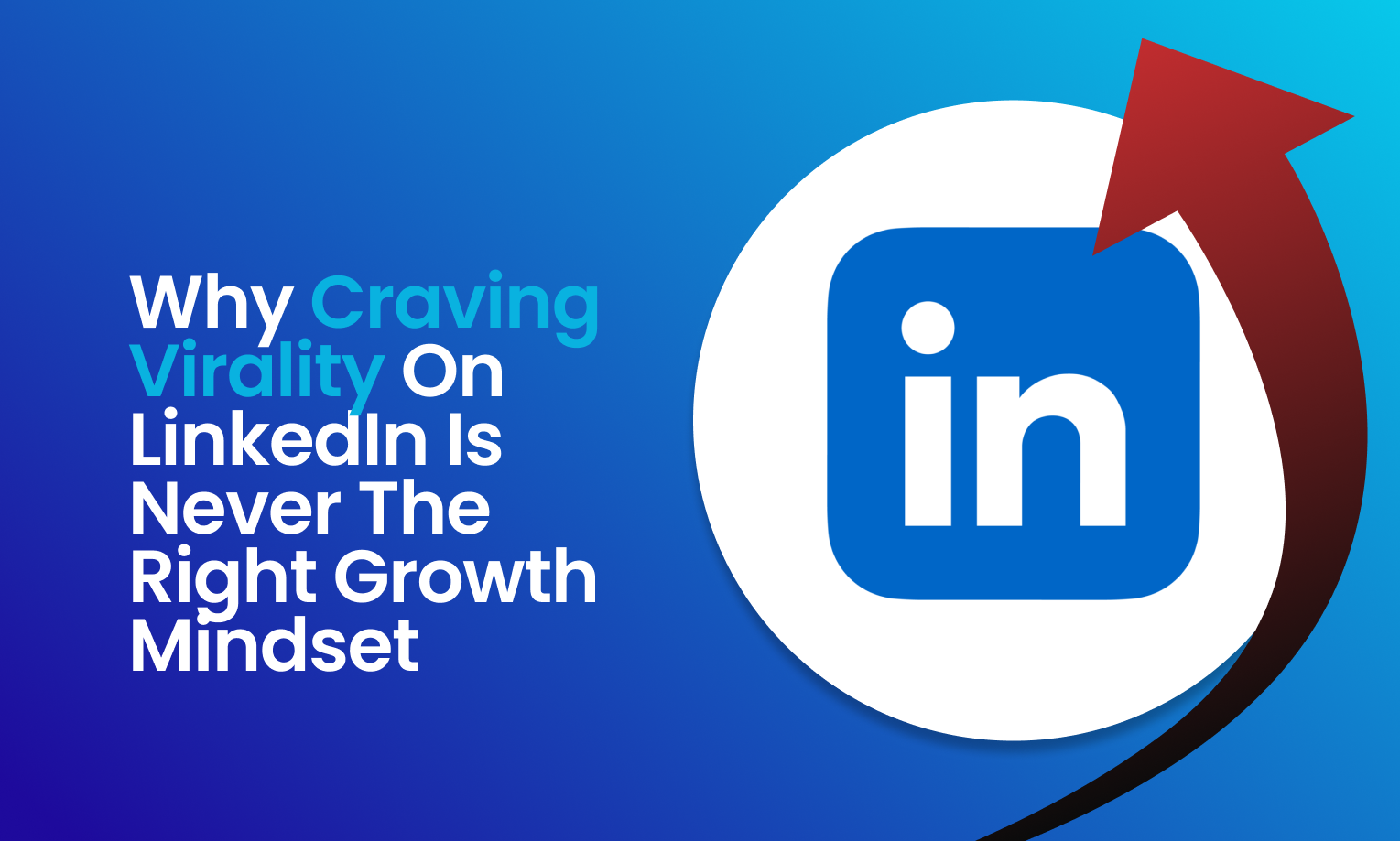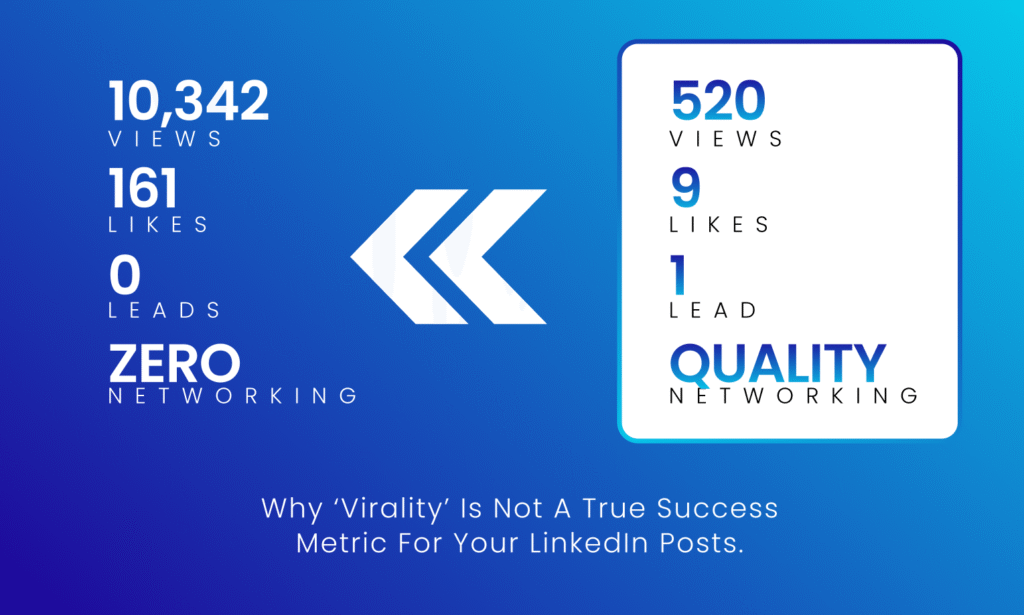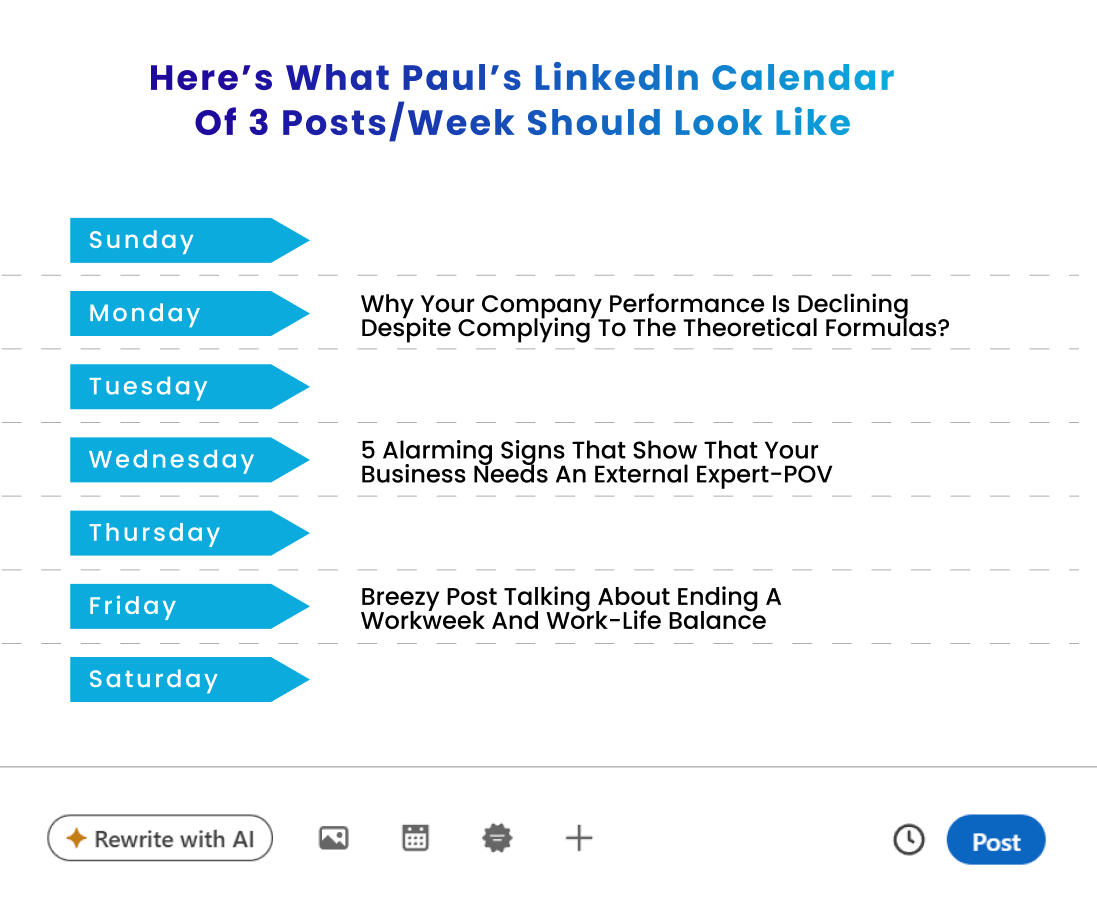
Paul, a 48-year-old business owner, runs a mid-sized business consulting firm in Philadelphia. Recently, he has been actively using LinkedIn.
While scrolling, he often comes across these LinkedIn posts getting thousands of likes and hundreds of comments every day on his feed.
Most of these posts resonate with him, and just like those creators, he wants to become popular on LinkedIn too. He also watches tech founders and marketers talking about generating leads and other business opportunities on the platform.
“Getting popular and more revenue? I definitely want that!”
But getting famous and generating leads on LinkedIn often don’t go hand-in-hand.
You can be a successful creator on LinkedIn without going viral or gaining a million followers.
How, you might ask? Read the next section of this blog article to understand it.
LinkedIn Isn’t Built for Virality. It’s Built for Relevance.
Let’s get something straight:
The viral posts that Paul was reading on his feed were generic posts, which were written to appeal masses.
But if you want to bag more revenue for your business, you should write for that small group of people you want to work with.
There’s a reason why LinkedIn’s algorithm isn’t specifically built for virality.
Instead, it’s engineered to display relevant, high-value professional content.
According to Hootsuite’s April 2025 deep dive, the algorithm’s decision process comprises three key stages:
- Quality Filtering: Spammy or low-value content is removed right away. This includes clickbait headlines, excessive hashtags, or posts riddled with grammar issues.
- Engagement Testing (“The Golden Hour”): Once you post, your content is shown to a small segment of your audience. If people leave thoughtful comments early, your post gets pushed further.
- Relevance Ranking: What ends up in someone’s feed depends on how close your content is to their professional interests, skill set, location, and past interactions.
As Jesse Wisnewski says,
“Fake engagement is out. Genuine expertise wins.”
The crux is: Stop chasing virality. Instead, chase relevance, resonance, and real conversations.
Why Getting 9 Likes Isn’t a Bad Thing

Paul once posted a carousel about consulting strategies for family-run businesses. It got just 9 likes. At first, he felt disappointed. But then something interesting happened—he received two messages.
- One from another consulting firm owner who wanted to pick his brain.
- And one from a potential lead inquiring about his services
That’s when it clicked.
If you’re in a niche industry, it’s perfectly fine if your posts don’t rack up triple-digit engagement. Why? Because you’re not trying to impress the whole LinkedIn community. You’re talking directly to your Ideal Customer Profile (ICP).
One comment from a potential lead is worth more than 100 likes from people who’d never work with you.
Also read about how we helped CyberNet and its CEO win on LinkedIn, tailoring their organic content to their specific telecom sector.
4 Things to Focus On for Growth Without Virality
1. Understand What Your ICP Is Struggling With
Your content shouldn’t be about everything under the sun. Instead, narrow it down to what your potential buyers are worried about.
Are they losing clients to newer competitors? Are they struggling with outdated business processes?
Agitate those pain points. Use storytelling, share personal failures, sprinkle in authority-driven facts, and always end with a small insight or takeaway. That’s how Paul started turning attention into connection.
2. So, Should You Only Create Niche Content?
Not really.
Mix it up.
Let’s say you’re writing 3 posts per week:
- Keep 2 focused on your industry or customer problems
- Dedicate 1 to something breezy—an anecdote, a personal story, or even a photo from your offsite team retreat.
This creates a balance. People relate to professionals but connect with humans.

3. Repeat What’s Working
If a particular post style or topic gets more meaningful comments or DMs, don’t shy away from repeating the format.
Paul noticed that when he used the “Problem – Process – Personal Win” format in text posts, he got better conversations. He now uses that format every alternate Thursday. No shame in reusing what works.
4. Stop Caring About the Algorithm—Start Caring About People
While the algorithm helps, it’s people who convert, comment, and remember.
Before you post anything, ask:
“Will this help someone like my dream client?”
If yes, then publish it. If not, rewrite it until it does.
Extra Tips to Boost Organic Engagement on LinkedIn
Here are some small but powerful things Paul—and you—can do consistently:
1. Be Real and Honest
Don’t recycle viral opinions from other creators. Instead, acknowledge them and then add your take.
Example:
“I agree with what Alex Hormozi said about decision-making, but for small consulting firms, the context is different…”
This approach earns respect, not just likes.
2. Read Books and Stay Up-to-Date With Industry Trends
AI can give you repeated and overused prompts. But books?
They give you depth and natural writing prompts that nobody is thinking about.
When Paul started sharing one lesson per month from the books he read (like The Trusted Advisor), his posts stood out. Readers saw him as someone experienced who has gained wisdom from real experiences and reading meaningful books.
3. Engage With Other Creators Without Thinking About Competition
LinkedIn rewards activity. The more you comment, react, and share, the more visible your own content becomes.
Paul! If you’re reading this—yes, it’s okay to comment on other consulting firms’ posts.
They won’t steal your business. They might actually inspire your next post or even refer clients to you later. That’s how digital networking works!
4. Respond to the Comments on Your Posts
If someone takes the time to leave a thoughtful comment, you owe them a response.
Even a “Thanks for sharing that insight, Sarah” goes a long way. It boosts visibility, deepens relationships, and shows others that you’re approachable, not just broadcasting.
5. Follow and Connect With People You Like on LinkedIn
Don’t wait for others to find you. Actively follow people whose content you respect, and connect with those you’d enjoy learning from.
Paul started following 10 people in the consulting + tech crossover space, and now his feed is richer and more focused. That’s what made it easier for him to engage, get inspired, and post better.
Conclusion: Build, Don’t Chase
You don’t need to go viral to win on LinkedIn in 2025.
You need to be relevant to the right people, clear about your expertise, and consistent with your efforts.
Paul didn’t hit 10,000 followers. But he booked 3 new consulting clients, hired a talented intern through LinkedIn DMs, and got invited to a niche conference—all because he stopped craving virality and started speaking to his tribe.
Do the same.
You’re not here only to become famous.
You’re here to become trusted.


